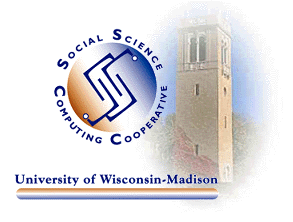
SSCC's oldest UNIX computer, GUY, is now five years old and near the end of its expected life cycle. This year we will begin a gradual phase out of GUY. The time line is listed below:
| Date | Action |
| February 4, 2002 | Remove STATA from GUY and NORMAN; move all other statistical software except SAS currently on GUY to NORMAN. |
| August 5, 2002 | Remove SAS from GUY (Version 6 SAS data sets need to be converted to version 8 by this date -- details below). |
| September 3, 2002 | Retire GUY. |
If this news is shocking to you, consider this:
Numerically intensive SAS or STATA jobs take three to five times longer to run on GUY than any other SSCC computer.
SSCC UNIX computers have ample CPU cycles to compensate for the loss of GUY's cycles because of recent computer purchases. KITE, SSCC's latest purchase, is available to all SSCC users and has both SAS and STATA installed, just like GUY. The table below shows the current status of each of SSCC's UNIX computers including who has access and SAS, SPSS, and STATA availability:
| Server |
CPU |
No.
CPUs |
RAM
in Mb |
UNIX O.S. Variant |
Access | Software |
| ELAINE | 466 | 1 | 640 | Tru64 | Soc, Rur | SAS, STATA |
| HAL | 500 | 2 | 2569 | Tru64 | All | STATA |
| KITE | 1000 | 2 | 1024 | Linux | All | SAS, STATA |
| MARIAH | 466 | 1 | 640 | Tru64 | CDE | SAS, STATA |
| NORMAN | 466 | 1 | 640 | Tru64 | All | SPSS |
The column labeled "UNIX O.S. Variant" indicates which "flavor" of the UNIX operating system the computer is running: Linux or Tru64. KITE runs Linux which is a type of UNIX running on a PC server and veteran UNIX users will notice few or no differences. KITE has access to the entire UNIX file system just like the Tru64 computers. You can connect to KITE by typing "ssh kite" from any UNIX prompt or you can connect directly to KITE the same way you connect to any other UNIX computer. For example, if you connect to UNIX via an X-term, KITE is one of the choices on the login chooser list. If you connect via SecureCRT or X-Win32, you'll want to set up a session for KITE. For SecureCRT instructions, refer to SSCC's on-line documentation. For X-Win32 instructions, refer to SSCC's on-line documentation.
Both Stata Corp. and SAS Institute are enthusiastic in their support for Linux and STATA or SAS code written for Tru64 will work without modification. STATA and version 7 and above SAS data sets are also compatible across Tru64 and Linux. IF YOU STILL HAVE VERSION 6 SAS DATA SETS, BE SURE AND READ THE LAST SECTION OF THIS DOCUMENT.
So, which computer should you use? The table below should help you decide:
| Computer | Recommended Uses |
| ELAINE | For members of the Departments of Sociology and Rural Sociology carrying out routine tasks like using Pine, text editing, and running smaller SAS and Stata jobs. |
| HAL | For anyone doing major number crunching except SAS. |
| KITE | For anyone needing to do major SAS or STATA number crunching. Also, the computer for submitting Condor jobs. For SSCC members not affiliated with Sociology, Rural Sociology, or CDE, this is the only computer available to you which will have SAS after August 5. |
| MARIAH | For members of CDE carrying out routine tasks like using Pine, text editing, and running smaller SAS and Stata jobs. |
| NORMAN | For anyone carrying out routine tasks like using Pine, text editing, and running less commonly used statistical software like SPSS and LISREL. |
Prior to version 7, SAS data sets could only be read by the same operating system that created them. Beginning with version 7, they are much more portable. Data sets made with version 7 or 8 of SAS on one of SSCC's Tru64 computers can be used by the new Linux computers without any changes, but data sets made with version 6 cannot.
Even though we upgraded from version 6 of SAS almost three years ago, we still have a lot of version 6 SAS data sets on our UNIX system. To make the transition from GUY to KITE smoother, SSCC staff are writing a program that will find all the version 6 SAS data sets and convert them to version 8 for you. We will provide you with more details about this at a later date.
Converting a SAS version 6 data set to version 8 is actually very simple. The SAS program only requires four lines of code and converts all the SAS data sets in a single directory. So, if you want to do this yourself, we have written a handout to assist you which explains how to first find all your version 6 SAS data sets and then how to convert them to version 8. A SAS macro program is included to help automate the process.
Please contact the Consultant with any questions you may have. We are very eager to help.
Go to previous editions of
SSCC News.
Go to the SSCC Home Page.
© 2001 University of Wisconsin Social Science Computing Cooperative